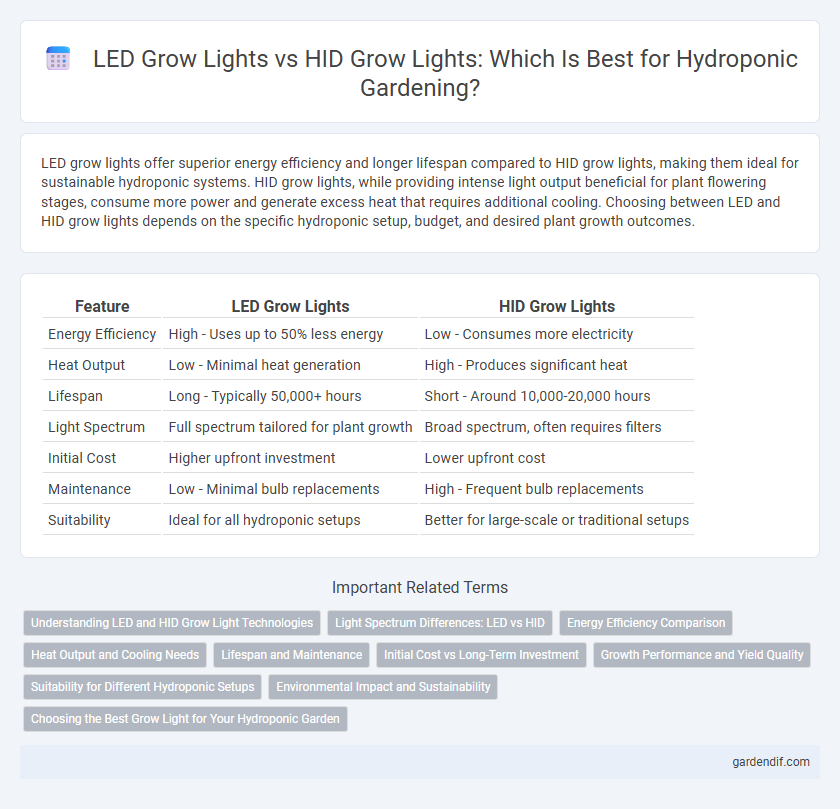
LED Grow Lights vs HID Grow Lights Illustration
LED grow lights offer superior energy efficiency and longer lifespan compared to HID grow lights, making them ideal for sustainable hydroponic systems. HID grow lights, while providing intense light output beneficial for plant flowering stages, consume more power and generate excess heat that requires additional cooling. Choosing between LED and HID grow lights depends on the specific hydroponic setup, budget, and desired plant growth outcomes.
Table of Comparison
| Feature | LED Grow Lights | HID Grow Lights |
|---|---|---|
| Energy Efficiency | High - Uses up to 50% less energy | Low - Consumes more electricity |
| Heat Output | Low - Minimal heat generation | High - Produces significant heat |
| Lifespan | Long - Typically 50,000+ hours | Short - Around 10,000-20,000 hours |
| Light Spectrum | Full spectrum tailored for plant growth | Broad spectrum, often requires filters |
| Initial Cost | Higher upfront investment | Lower upfront cost |
| Maintenance | Low - Minimal bulb replacements | High - Frequent bulb replacements |
| Suitability | Ideal for all hydroponic setups | Better for large-scale or traditional setups |
Understanding LED and HID Grow Light Technologies
LED grow lights utilize light-emitting diodes to deliver targeted spectra ideal for plant growth, offering higher energy efficiency and longer lifespans than HID lights. HID grow lights, including metal halide (MH) and high-pressure sodium (HPS) lamps, produce intense, broad-spectrum light through gas discharge but consume more power and generate significant heat. Understanding the differences in light output, energy consumption, and heat management is essential for optimizing hydroponic crop yields with either LED or HID technology.
Light Spectrum Differences: LED vs HID
LED grow lights provide a customizable light spectrum with precise peaks in blue and red wavelengths, optimizing photosynthesis and plant growth efficiency. HID grow lights, such as metal halide and high-pressure sodium, emit a broader, less targeted light spectrum, often generating excess heat that can stress plants. The spectral control of LEDs leads to better energy use and healthier crop development compared to the less efficient and more heat-heavy HID systems.
Energy Efficiency Comparison
LED grow lights consume 40-60% less energy compared to HID grow lights, making them significantly more energy-efficient for hydroponic systems. LEDs convert a higher percentage of electricity into usable light, with efficacy levels reaching up to 150-200 micromoles per joule, whereas HID lights typically range between 80-120 micromoles per joule. Reduced heat output from LEDs also decreases cooling costs, further enhancing overall energy savings in indoor hydroponic cultivation.
Heat Output and Cooling Needs
LED grow lights produce significantly less heat compared to HID grow lights, making them more energy-efficient and reducing the risk of heat stress on plants. Lower heat output from LED lights minimizes cooling requirements, allowing for simpler and less costly ventilation systems in hydroponic setups. HID lights, while powerful, generate substantial heat that demands robust cooling solutions to maintain optimal growing temperatures and prevent plant damage.
Lifespan and Maintenance
LED grow lights offer a significantly longer lifespan, often exceeding 50,000 hours compared to HID grow lights, which typically last around 15,000 to 20,000 hours. Maintenance requirements for LED lights are minimal due to their durable design and low heat output, reducing cooling and replacement needs. HID lights demand more frequent bulb replacements and regular ballast maintenance, increasing operational costs and downtime for hydroponic growers.
Initial Cost vs Long-Term Investment
LED grow lights typically have a higher initial cost than HID grow lights but offer greater energy efficiency, longer lifespan, and lower maintenance expenses, resulting in reduced operational costs over time. HID grow lights require frequent bulb replacements and consume more electricity, increasing long-term expenses despite their lower upfront price. Choosing LED lights can lead to significant savings and better return on investment in hydroponic systems through improved durability and energy savings.
Growth Performance and Yield Quality
LED grow lights offer superior energy efficiency and targeted light spectrums that enhance photosynthesis, resulting in faster plant growth and improved yield quality compared to HID grow lights. HID lights generate more heat and consume higher power, which can stress plants and reduce overall growth performance. Controlled spectral output from LEDs promotes healthier root development and nutrient uptake, directly influencing higher yield consistency and potency in hydroponic systems.
Suitability for Different Hydroponic Setups
LED grow lights offer superior energy efficiency and customizable light spectrums, making them ideal for small to medium hydroponic setups with limited space. HID grow lights, particularly metal halide (MH) and high-pressure sodium (HPS) lamps, provide intense light output suitable for large-scale hydroponic farms requiring deep canopy penetration. The choice between LED and HID systems depends on factors such as setup size, crop type, and energy consumption preferences.
Environmental Impact and Sustainability
LED grow lights consume significantly less energy than HID grow lights, reducing greenhouse gas emissions and lowering operational costs for hydroponic systems. Their longer lifespan decreases waste generation, contributing to a more sustainable cultivation environment. HID grow lights produce more heat, increasing the need for cooling systems that elevate energy consumption and carbon footprint in indoor farming setups.
Choosing the Best Grow Light for Your Hydroponic Garden
LED grow lights offer superior energy efficiency, lower heat output, and longer lifespan compared to HID grow lights, making them ideal for hydroponic gardens where temperature control and electricity costs are critical. HID grow lights, such as Metal Halide (MH) and High-Pressure Sodium (HPS), provide intense full-spectrum light beneficial for different plant growth stages but generate more heat and consume more power. Selecting the best grow light depends on factors like plant type, growth phase, available space, and budget, with LEDs increasingly favored for their customizable spectrum and operational savings in hydroponic setups.
LED Grow Lights vs HID Grow Lights Infographic

 gardendif.com
gardendif.com